LEPREON (ZHR), Ancient city, ILIA

Other Names: LEPREUM, LEPREUS (Bibliography)
Postal Code: 27056
Tel +30 26250
Ancient Temple in Peloponnese Peninsula
http://www.gtp.gr/AncientLepreum
Foundations of a Doric Greek Temple measuring 20 by 10 metres which originally had 11 by 6 columns dating to the end of the 4th Century BCE. Pausanias stated this was a temple of Demeter.
There are also supposed to be remains of town walls and graves.
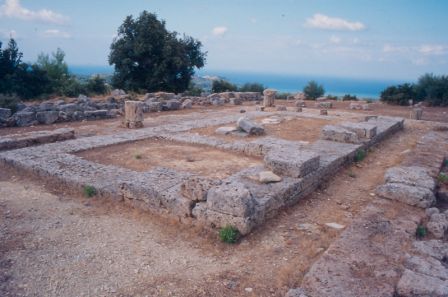
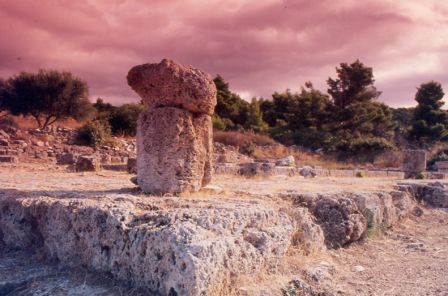
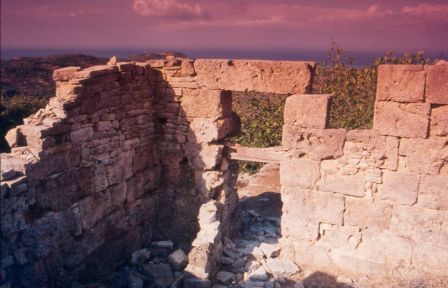
The walls and the gate of Lepreon.
The temple of Athena, ancient Figaleia



The temple of Athena and Zeus of Savior constitute the most appreciable monument of ancient Figaleia that is extended in the place of the current community. Figaleia was one of the important Arcadian cities and dedicated the temple of Apollo Epicurius in Basses. The temple of Athena and Zeus is located in the low hill of "Kourdoumpouli", south-western of the ''Agora'' of the ancient city. It is a rectangle temple with ''pronao'' and ''cella'', and orientation from the East to the West. Its period of life extends from the 4th century B.C. until the early Roman period, while probably existed an archaic phase as well. The temple is not reported by Paysania and the identification of worshipped deities was inscribed on the statues bases.
The excavation showed that the life in this particular hill had already begun from the prehistoric period. The Sanctuary existed from the archaic period, as it emerges from the architectural ruins, as well as from the offerings. In the Byzantine period or in the period of the Frankish Occupation the temple seems to be transformed into a house.
The temple of the 4th century. BC, is a rectangle building with pronao and enclosure. It is made of large rectangular stones in irregular system. The entrance is on the east and has a threshold. The ''pronaos'' communicates with the enclosure via a monolith threshold. At the bottom of the cella was found the cubic stone of the statue of worship. In the ''plateau',' that is formed in front of the facade of the temple, was probably the altar.
The temple is located in the southern part of ancient Figaleia. The city is surrounded by strong fortification of 4,5 km length and has citadel in the north-east. The ancient sources refer ''Agora'', Gymnasium, Theatre, as well as temples of Artemis, Dionysus Akratoforou and Eyrynomis. On coins of the city it appears that they worshiped Health, Asklipius, Aphrodite and Neda or Chance. From the ancient city has been excavated, so far, the fountain of the early Hellenistic period and funerary monuments of the Hellenistic period which are similar with those of ancient Alifeiras and Messina.
The Temple of Athena and Zeus Savior was a religious and political centre of ancient Figaleias. From the inscriptions it emerges that the temple had political importance and that its scope extends beyond the limits of Arcadia. It has several similarities to the construction and arrangement of internal spaces with the temple of Asclepius in Alifeira.
5th Century BCE Doric limestone temple. It is one of the best preserved Greek temples but needed to be saved from collapse in the mid 1970s. The internal friezes are now in the British Museum. The location is said to be not easy to reach but quite spectacular.
Nearest Village: Andritsena Nearest Ciry: Pyrgos
Latitude: 37.430126N
Longitude: 21.899804E


 This famous temple to the god of healing and the sun was built towards the middle of the 5th century B.C. in the lonely heights of the Arcadian mountains. The temple, which has the oldest Corinthian capital yet found, combines the Archaic style and the serenity of the Doric style with some daring architectural features.Isolated as it is in a conserved environment, the Temple of Bassae is an outstanding example of a Hellenic votive sanctuary in a rural setting. It represents a unique artistic achievement, remarkable for its archaic features (elongated surface, an exceptional proportion of 15 columns on the longer side and 6 columns on the facade, and a north-south exposure), and for its daring innovations (the use of Ionic and Corinthian orders for a Doric edifice, the variety of materials used, and the originality of the layout of the cella and the adyton).
This famous temple to the god of healing and the sun was built towards the middle of the 5th century B.C. in the lonely heights of the Arcadian mountains. The temple, which has the oldest Corinthian capital yet found, combines the Archaic style and the serenity of the Doric style with some daring architectural features.Isolated as it is in a conserved environment, the Temple of Bassae is an outstanding example of a Hellenic votive sanctuary in a rural setting. It represents a unique artistic achievement, remarkable for its archaic features (elongated surface, an exceptional proportion of 15 columns on the longer side and 6 columns on the facade, and a north-south exposure), and for its daring innovations (the use of Ionic and Corinthian orders for a Doric edifice, the variety of materials used, and the originality of the layout of the cella and the adyton).
The Temple was dedicated by the inhabitants of Philagia to Apollo Epicurius, the god-healer who had come to their aid when they were beset by the plague. Its ruins rise majestically to 1,130 m high in the mountainous region of Arcadia in the heart of the Peloponnese, near Andritsaina. Built in the second half of the 5th century BC (c. 420-410 BC?), it belongs to the first generation of post-Parthenonian edifices. Pausanias admired its beauty and harmony and, moreover, attributed it to the architect Ictinos, although contemporary archaeologists have been unable to provide confirmation.
With its elongated dimensions (39.87 m by 16.13 m), the peripteral structure is built mainly in grey limestone of local origin. The outer colonnade of the hexastyle temple respects an extremely strict Doric order (the metopes are not sculptured). Inside, however, fine-quality sculpturing blends with a more sophisticated architectural style. The front of the pronaos and the opisthodomos, with two in antis columns, restate the Doric order. In the cella, however, a series of embedded Ionic columns stand against low support walls. On the southern side, where an adyton is located, the last two Ionic columns standing in the cella at the far end of the oblique walls flank one Corinthian column which stands alone in the centre of the temple. The decoration is notable, particularly by virtue of the different materials used: the walls and the bases and tambours of the columns are limestone, and the Ionic capitals and the Corinthian capital are in Doliana marble, as are the sculptured metopes of the exterior frieze of the cella, the plates of the Ionic frieze which runs along the inside of the sanctuary, the guttae, the roof supports and the roofing tiles.
The capital of the central column of the Temple of Bassae is the most ancient conserved Corinthian capital, and as such the temple may be considered a model for all 'Corinthian' monuments of Greek, Roman and subsequent civilizations.
Being located away from the city, the temple long remained undiscovered. A French architect came upon it accidentally in 1765 and brought it to the attention of the academic world. The first archaeological investigation in 1812 was profitable but at the same time prejudicial for the integrity of the site. The discovery of the Ionic frieze's 22 sculptured plates ultimately divested the site of these remarkable sculptures, which were acquired in 1814 by order of the future King George IV of England and transferred to the British Museum along with the Corinthian capital. Deprived of decorations of exceptional quality (a Centauromachy and an Amazonomachy), the Temple of Bassae was carefully restored in 1902, but in 1965 the critical state of the monument called for renewed renovation.In the Municipality of Andritsena, on the hill situated above the settlement of Theisoa, the visitor meets scattered parts of the ancient temple of the same style with the temple of Apollo Epicurius (430-429 B.C.). At the site of the ancient fortification, which is extant until today, was built the fortress of Saint Helen. (1209 - 1275 A.D.).
Behind this hill is located the valley of Soultina and the river Myleon , which starts from the Mount Lykaion, that, according to the tradition, was the birthplace of Zeus. The nymph Theisoa was Zeus nurse and the modern settlement is named after her. In 1996, during the construction of the Theisoa-Matesi road, a cemetery was revealed, probably of the Hellenistic era.
Vresto in Alifira
 The extended (extensive) ruins, which are found in the location of Vrestos, are identified with the city of "Pteleos", which took part in the Trojan War, as Homer mentions as well.
The extended (extensive) ruins, which are found in the location of Vrestos, are identified with the city of "Pteleos", which took part in the Trojan War, as Homer mentions as well.
According to Strabo's Geography, "Pteleos" was built by colonists, who came from the homonymous city of Thessaly. He mentions that there was "an uninhabited village with dense forest, called Ptelasion".
The remains are of houses, theatre, public buildings and walls with towers.
Postal Code: 27061
Tel +30 26260
Altitude: 544 meters
Longitude: 21o 48' 00.23" E
Latitude: 37o 30' 31.76" N
Ancient Figaleia


Ancient Figaleia
Ancient Figaleia (or Phigaleia) was a thriving and important city in ancient Arcadia.Located near the present villages of Ilia Phigaleia and gardens in the beautiful valley of the river Neda. Neda (the only female river) got its name from the nymph Neda, a goddess of water. The city was built on a hill, with many walls around cliffs and powerful ocheirotiko enclosure and ekosmeito of fine statues. The city was the Temple of Artemis "soteiras" with a stone statue of the goddess and a gym with beautiful statues of Hermes and the Olympic pankration Arrachiona. The Figalias had two sacred mountains. The Kotilion term, where they built the temple of Apollo and oil condition (south of the village of Ilia throat), on the south side of which was a cave overlooking the deep gorge, where worshiped Melaena Demeter.
The Figalias that erepan the feast and the good life and were lovers of wine and travel. They even build a temple dedicated to Dionysos the akratoforo, whose statue shone red through the vines, painted with cinnabar (mercury sulfide). In Roman times the Figalias minted coins showed Neda in the form of God holding the hands of the pitcher from which water is poured.
The city was founded by Figalias, son Lykaona, founder of Lykosoura. In 659 BCThe city was conquered by the Spartans, with whom he makrochonia controversy.The Figalias losing their freedom fled their homeland. After a few years called an oracle from the Pythia whether to regain their homeland and freedom touspolemontas Spartans. She answered them not see this, unless offered one hundred Oresthasioi volunteers to fight, but they will all die. The Oresthasioi, found it obvious to offer and we all die, as was the oracle, to give freedom to Figalias. And so it happened and later Figalias retook the city. (Pausanias Arcadian 39, 2-4). The Figalias to remember the supreme offering of one hundred Oresthasion erected a column he wrote:
"Polyandrion Oresthasion not admired, stranger. Arcades are one. Self-appointed gar death elontes, Figalefsin eleftheriin edomen "
ie:
"The Polyandrion Oresthasion not admiring stranger. Arcades are. After our own death we chose, in Figalias donated the freedom "
Comments and transfer the current situation is left to the reader ... Today at ancient Figalias ruins of the ancient temple of Artemis with an impressive altar. In the surrounding area are easily the walls of the fortification wall on the steep slopes and hills that were once filled with vines Phigaleia. The archaeological site excavations are ongoing.
Ancient city Platiana










37° 32' 25.78" N 21° 45' 8.67" E
The ruins of the ancient city (Typaneai or Aipy) are on the hill Lapithas southernly of the village Platiana (Olympias' province), It is located in the hinterland, 17 km Eastern (in straight line) from the nearest coast of Kyparissia. It is a fortified, elliptic and elongated city, which is surrounded by a line of walls, probably of the 4th or 3rd century B.C. The city is saved in its entirety in very good condition (in certain points round the 5m. height).
It has three big gates to the north-west, south-west and east, which is the main gate, as well as several defensive towers. The walls are built by blocks of stone. The exterior side has a flat surface, while internal has stones of medium size.
The fortified city has biggest length 660m and maximum width, including the north-west extension of the wall, 200m, while the rest does not exist the 100 m width. It is divided in 8 ''andira'' (level surfaces), with bent from west to east.
In one of the ''andira'' there is a theatre. A part of its scene and its concave is saved, while in others there are a) the "Acropolis", b) the "Agora as well as g) the ''analimma'' of the Temple. In the side there exist foundations of several constructions. From them, it stands out a rectangular floor that is saved in enough height. It is probably houses, perhaps for the eminent persons.
Regarding the cemetery of the ancient city, various clues place it in a nape between the hills of the fortified city and in another smaller, located a few hundreds meters west.
Agia Triada Mycenaean cemetery
In the north east Ilia, near the borders of the prefectures of Ilia and Achaia and in short distance from the borders of Antroni and Agia Triada, in Paliompokobina, has been found an extensive Mycenaean cemetery. The graves are carved on the slope of a small hill, and arranged in rows (cubed in lines), oriented N-S and E-W.
There were searched fifty graves/tombs and the discoveries were important. There were found five hundred (500) vessels.
In the decoration of the vessels we mostly see semicircles, triangles, flowers, undulate lines etc. The figurative subjects are few. Most important is the representation of the dead person laid down that was maintained in the shells of a crater.
The findings from the cemetery are almost 1500.
The most important are: two bronze buckles, bronze and bone pins, razors, a gold and appended by a mountain crystal, a gold necklace, eight hundred (800) of beads of various types, two quills, thirteen seal stones, eight bronze knives, several teeth of boars, helmets, a sword, two bronze vases.
Kato Ancient Samias

City of Trifylias, which was founded southerly of Olympia and the valley of Alfios. Its location was exceptionally important since it connected the north-west Peloponnese with the South-west, that's why later on it was named Kledi (Key) by the local people. More specifically we would say that it is placed at the western foot of the mountain Lapitha. The findings show that the 4rth century the citadel is fortified by strong wall with towers. Today the walls are visible and at a height of 180 meters north of the lake of Kaiafa. Its residents worshipped Poseidon (a cult that brings in mind the description, in the Homeric Odyssey, of the ceremonies that the residents of Pylos held to honour Poseidon). In the Southern side of Samiko there was the so called ''cave of Anigridon Nymphs'' that spurted therapeutical water for the treatment of skin diseases.
In the location Kledi, north of Samiko, Doerpfeld found Mycenaean shells and ruins of cyclopean walls. Also, in 1954, N.Gialoyris found a tomb with graves, in which there were found vessels of the Mycenaean years. Due to the excavator the tomb was built to honour Iardano. The excavations were repeated by El. Papakonstantinoy in the early '80s and they brought into light four more tumuli and a domed tomb that was built inside a tomb.
The last case is exceptionally interesting since it shows that the Mycenaean constructors selected the tomb, continuing the uninterrupted use of the area as burial space and testifying that they belonged in the same race with the Mesoelladites (previous inhabitants of the area).
In the region there still exist ruins of the ancient city Samias, which Paysanias identifies with the Homeric Citadel Arini. Is it also saved a fortified wall that is dated in the Macedonian Period. In the place Kledi, there were revealed relics of a cyclopean wall, a cemetery and a vaulted grave.
Ancient Skillountia

City of Trifylias, which abstains 3.5 km from Olympia. The excavations that have been held in the region of Prophet Ilias Makrision, showed that there had been established a settlement already from the middle (mesoelladiki) period.
Skillous, during the 7th-6th century B.C, had friendly relationship with the city of Pisates, fact that was enough for the Ilians to destroy the city in 572 B.C. Aound 400 B.C. it was dominated by the Spartans, that afterwards granted in Xenofon a big part of the area. Xenophon settled there and founded the Temple of Artemis. The goddess, as it is known, was the protector of hunting. The Athenian historian described hunting scenes. He, his sons and their guests were hunting wild boars and deer in Foloi.
The excavation showed that the life in this particular hill had already begun from the prehistoric period. The Sanctuary existed from the archaic period, as it emerges from the architectural ruins, as well as from the offerings. In the Byzantine period or in the period of the Frankish Occupation the temple seems to be transformed into a house.
The temple of the 4th century. BC, is a rectangle building with pronao and enclosure. It is made of large rectangular stones in irregular system. The entrance is on the east and has a threshold. The ''pronaos'' communicates with the enclosure via a monolith threshold. At the bottom of the cella was found the cubic stone of the statue of worship. In the ''plateau',' that is formed in front of the facade of the temple, was probably the altar.
The temple is located in the southern part of ancient Figaleia. The city is surrounded by strong fortification of 4,5 km length and has citadel in the north-east. The ancient sources refer ''Agora'', Gymnasium, Theatre, as well as temples of Artemis, Dionysus Akratoforou and Eyrynomis. On coins of the city it appears that they worshiped Health, Asklipius, Aphrodite and Neda or Chance. From the ancient city has been excavated, so far, the fountain of the early Hellenistic period and funerary monuments of the Hellenistic period which are similar with those of ancient Alifeiras and Messina.
The Temple of Athena and Zeus Savior was a religious and political centre of ancient Figaleias. From the inscriptions it emerges that the temple had political importance and that its scope extends beyond the limits of Arcadia. It has several similarities to the construction and arrangement of internal spaces with the temple of Asclepius in Alifeira.
Bassae Temple of Apollo Epicurius
5th Century BCE Doric limestone temple. It is one of the best preserved Greek temples but needed to be saved from collapse in the mid 1970s. The internal friezes are now in the British Museum. The location is said to be not easy to reach but quite spectacular.
Latitude: 37.430126N
Longitude: 21.899804E



The Temple was dedicated by the inhabitants of Philagia to Apollo Epicurius, the god-healer who had come to their aid when they were beset by the plague. Its ruins rise majestically to 1,130 m high in the mountainous region of Arcadia in the heart of the Peloponnese, near Andritsaina. Built in the second half of the 5th century BC (c. 420-410 BC?), it belongs to the first generation of post-Parthenonian edifices. Pausanias admired its beauty and harmony and, moreover, attributed it to the architect Ictinos, although contemporary archaeologists have been unable to provide confirmation.
With its elongated dimensions (39.87 m by 16.13 m), the peripteral structure is built mainly in grey limestone of local origin. The outer colonnade of the hexastyle temple respects an extremely strict Doric order (the metopes are not sculptured). Inside, however, fine-quality sculpturing blends with a more sophisticated architectural style. The front of the pronaos and the opisthodomos, with two in antis columns, restate the Doric order. In the cella, however, a series of embedded Ionic columns stand against low support walls. On the southern side, where an adyton is located, the last two Ionic columns standing in the cella at the far end of the oblique walls flank one Corinthian column which stands alone in the centre of the temple. The decoration is notable, particularly by virtue of the different materials used: the walls and the bases and tambours of the columns are limestone, and the Ionic capitals and the Corinthian capital are in Doliana marble, as are the sculptured metopes of the exterior frieze of the cella, the plates of the Ionic frieze which runs along the inside of the sanctuary, the guttae, the roof supports and the roofing tiles.
The capital of the central column of the Temple of Bassae is the most ancient conserved Corinthian capital, and as such the temple may be considered a model for all 'Corinthian' monuments of Greek, Roman and subsequent civilizations.
Being located away from the city, the temple long remained undiscovered. A French architect came upon it accidentally in 1765 and brought it to the attention of the academic world. The first archaeological investigation in 1812 was profitable but at the same time prejudicial for the integrity of the site. The discovery of the Ionic frieze's 22 sculptured plates ultimately divested the site of these remarkable sculptures, which were acquired in 1814 by order of the future King George IV of England and transferred to the British Museum along with the Corinthian capital. Deprived of decorations of exceptional quality (a Centauromachy and an Amazonomachy), the Temple of Bassae was carefully restored in 1902, but in 1965 the critical state of the monument called for renewed renovation.In the Municipality of Andritsena, on the hill situated above the settlement of Theisoa, the visitor meets scattered parts of the ancient temple of the same style with the temple of Apollo Epicurius (430-429 B.C.). At the site of the ancient fortification, which is extant until today, was built the fortress of Saint Helen. (1209 - 1275 A.D.).
Behind this hill is located the valley of Soultina and the river Myleon , which starts from the Mount Lykaion, that, according to the tradition, was the birthplace of Zeus. The nymph Theisoa was Zeus nurse and the modern settlement is named after her. In 1996, during the construction of the Theisoa-Matesi road, a cemetery was revealed, probably of the Hellenistic era.
The Bassae Frieze has its own room at the British Museum.
Vresto in Alifira

According to Strabo's Geography, "Pteleos" was built by colonists, who came from the homonymous city of Thessaly. He mentions that there was "an uninhabited village with dense forest, called Ptelasion".
The remains are of houses, theatre, public buildings and walls with towers.
Postal Code: 27061
Tel +30 26260
Altitude: 544 meters
Longitude: 21o 48' 00.23" E
Latitude: 37o 30' 31.76" N
Ancient Figaleia

Ancient Figaleia (spring of the 4th century)
http://www.flickr.com/photos/artandmale/3024205771/in/photostream/
The Ancient Phigaleia was in antiquity one of the most powerful Arcadian cities. The modern Phigaleia is built on the remains of the ancient city, which had many sanctuaries and public buildings. Pausanias reports the existence of the sanctuaries of Artemis Savior, Dionysus Akratoforus and Eurynome, in addition to the Gymnasium and the Agora, where the statues of Hermes and of Arrachion, the Olympic champion, were.

Ancient Figaleia
Ancient Figaleia (or Phigaleia) was a thriving and important city in ancient Arcadia.Located near the present villages of Ilia Phigaleia and gardens in the beautiful valley of the river Neda. Neda (the only female river) got its name from the nymph Neda, a goddess of water. The city was built on a hill, with many walls around cliffs and powerful ocheirotiko enclosure and ekosmeito of fine statues. The city was the Temple of Artemis "soteiras" with a stone statue of the goddess and a gym with beautiful statues of Hermes and the Olympic pankration Arrachiona. The Figalias had two sacred mountains. The Kotilion term, where they built the temple of Apollo and oil condition (south of the village of Ilia throat), on the south side of which was a cave overlooking the deep gorge, where worshiped Melaena Demeter.
The Figalias that erepan the feast and the good life and were lovers of wine and travel. They even build a temple dedicated to Dionysos the akratoforo, whose statue shone red through the vines, painted with cinnabar (mercury sulfide). In Roman times the Figalias minted coins showed Neda in the form of God holding the hands of the pitcher from which water is poured.
The city was founded by Figalias, son Lykaona, founder of Lykosoura. In 659 BCThe city was conquered by the Spartans, with whom he makrochonia controversy.The Figalias losing their freedom fled their homeland. After a few years called an oracle from the Pythia whether to regain their homeland and freedom touspolemontas Spartans. She answered them not see this, unless offered one hundred Oresthasioi volunteers to fight, but they will all die. The Oresthasioi, found it obvious to offer and we all die, as was the oracle, to give freedom to Figalias. And so it happened and later Figalias retook the city. (Pausanias Arcadian 39, 2-4). The Figalias to remember the supreme offering of one hundred Oresthasion erected a column he wrote:
"Polyandrion Oresthasion not admired, stranger. Arcades are one. Self-appointed gar death elontes, Figalefsin eleftheriin edomen "
ie:
"The Polyandrion Oresthasion not admiring stranger. Arcades are. After our own death we chose, in Figalias donated the freedom "
Comments and transfer the current situation is left to the reader ... Today at ancient Figalias ruins of the ancient temple of Artemis with an impressive altar. In the surrounding area are easily the walls of the fortification wall on the steep slopes and hills that were once filled with vines Phigaleia. The archaeological site excavations are ongoing.
Ancient city Platiana






Ancient theater




37° 32' 25.78" N 21° 45' 8.67" E
The ruins of the ancient city (Typaneai or Aipy) are on the hill Lapithas southernly of the village Platiana (Olympias' province), It is located in the hinterland, 17 km Eastern (in straight line) from the nearest coast of Kyparissia. It is a fortified, elliptic and elongated city, which is surrounded by a line of walls, probably of the 4th or 3rd century B.C. The city is saved in its entirety in very good condition (in certain points round the 5m. height).
It has three big gates to the north-west, south-west and east, which is the main gate, as well as several defensive towers. The walls are built by blocks of stone. The exterior side has a flat surface, while internal has stones of medium size.
The fortified city has biggest length 660m and maximum width, including the north-west extension of the wall, 200m, while the rest does not exist the 100 m width. It is divided in 8 ''andira'' (level surfaces), with bent from west to east.
In one of the ''andira'' there is a theatre. A part of its scene and its concave is saved, while in others there are a) the "Acropolis", b) the "Agora as well as g) the ''analimma'' of the Temple. In the side there exist foundations of several constructions. From them, it stands out a rectangular floor that is saved in enough height. It is probably houses, perhaps for the eminent persons.
Regarding the cemetery of the ancient city, various clues place it in a nape between the hills of the fortified city and in another smaller, located a few hundreds meters west.
Agia Triada Mycenaean cemetery
In the north east Ilia, near the borders of the prefectures of Ilia and Achaia and in short distance from the borders of Antroni and Agia Triada, in Paliompokobina, has been found an extensive Mycenaean cemetery. The graves are carved on the slope of a small hill, and arranged in rows (cubed in lines), oriented N-S and E-W.
There were searched fifty graves/tombs and the discoveries were important. There were found five hundred (500) vessels.
In the decoration of the vessels we mostly see semicircles, triangles, flowers, undulate lines etc. The figurative subjects are few. Most important is the representation of the dead person laid down that was maintained in the shells of a crater.
The findings from the cemetery are almost 1500.
The most important are: two bronze buckles, bronze and bone pins, razors, a gold and appended by a mountain crystal, a gold necklace, eight hundred (800) of beads of various types, two quills, thirteen seal stones, eight bronze knives, several teeth of boars, helmets, a sword, two bronze vases.
Kato Ancient Samias

City of Trifylias, which was founded southerly of Olympia and the valley of Alfios. Its location was exceptionally important since it connected the north-west Peloponnese with the South-west, that's why later on it was named Kledi (Key) by the local people. More specifically we would say that it is placed at the western foot of the mountain Lapitha. The findings show that the 4rth century the citadel is fortified by strong wall with towers. Today the walls are visible and at a height of 180 meters north of the lake of Kaiafa. Its residents worshipped Poseidon (a cult that brings in mind the description, in the Homeric Odyssey, of the ceremonies that the residents of Pylos held to honour Poseidon). In the Southern side of Samiko there was the so called ''cave of Anigridon Nymphs'' that spurted therapeutical water for the treatment of skin diseases.
In the location Kledi, north of Samiko, Doerpfeld found Mycenaean shells and ruins of cyclopean walls. Also, in 1954, N.Gialoyris found a tomb with graves, in which there were found vessels of the Mycenaean years. Due to the excavator the tomb was built to honour Iardano. The excavations were repeated by El. Papakonstantinoy in the early '80s and they brought into light four more tumuli and a domed tomb that was built inside a tomb.
The last case is exceptionally interesting since it shows that the Mycenaean constructors selected the tomb, continuing the uninterrupted use of the area as burial space and testifying that they belonged in the same race with the Mesoelladites (previous inhabitants of the area).
In the region there still exist ruins of the ancient city Samias, which Paysanias identifies with the Homeric Citadel Arini. Is it also saved a fortified wall that is dated in the Macedonian Period. In the place Kledi, there were revealed relics of a cyclopean wall, a cemetery and a vaulted grave.
Ancient Skillountia

City of Trifylias, which abstains 3.5 km from Olympia. The excavations that have been held in the region of Prophet Ilias Makrision, showed that there had been established a settlement already from the middle (mesoelladiki) period.
Skillous, during the 7th-6th century B.C, had friendly relationship with the city of Pisates, fact that was enough for the Ilians to destroy the city in 572 B.C. Aound 400 B.C. it was dominated by the Spartans, that afterwards granted in Xenofon a big part of the area. Xenophon settled there and founded the Temple of Artemis. The goddess, as it is known, was the protector of hunting. The Athenian historian described hunting scenes. He, his sons and their guests were hunting wild boars and deer in Foloi.

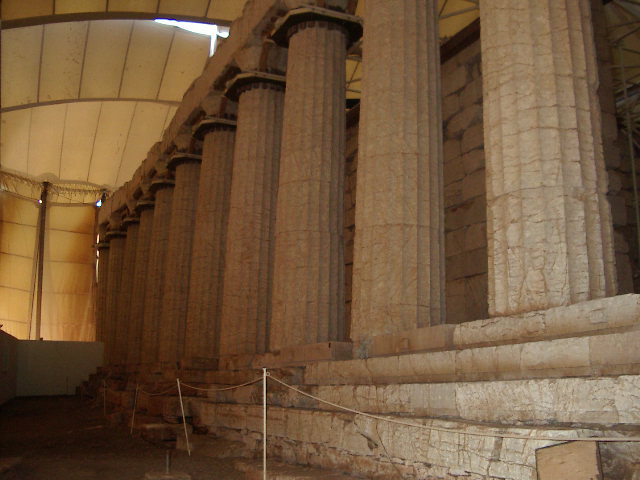
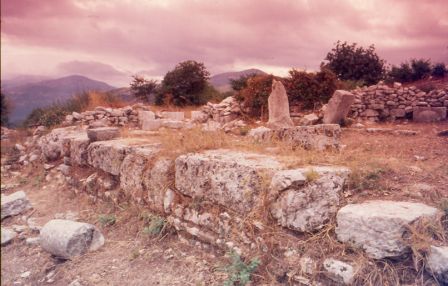
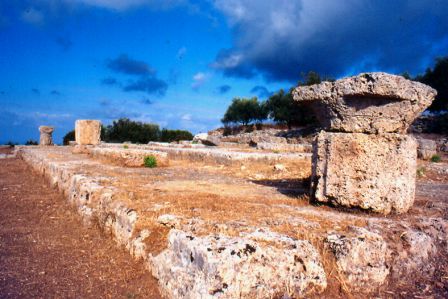

Δεν υπάρχουν σχόλια:
Δημοσίευση σχολίου